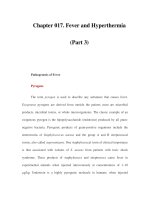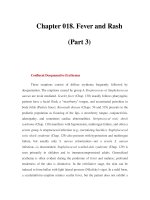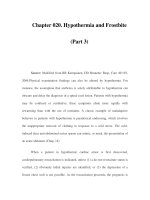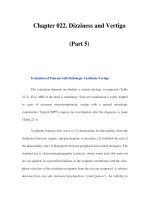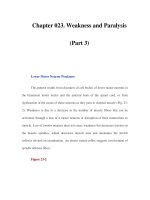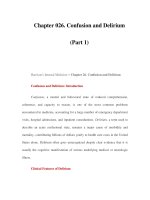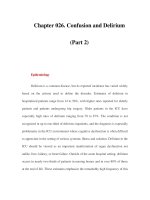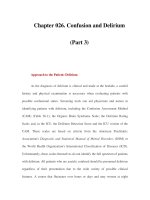Chapter 026. Confusion and Delirium (Part 3) pptx
Bạn đang xem bản rút gọn của tài liệu. Xem và tải ngay bản đầy đủ của tài liệu tại đây (16.59 KB, 5 trang )
Chapter 026. Confusion and Delirium
(Part 3)
Approach to the Patient: Delirium
As the diagnosis of delirium is clinical and made at the bedside, a careful
history and physical examination is necessary when evaluating patients with
possible confusional states. Screening tools can aid physicians and nurses in
identifying patients with delirium, including the Confusion Assessment Method
(CAM) (Table 26-1); the Organic Brain Syndrome Scale; the Delirium Rating
Scale; and, in the ICU, the Delirium Detection Score and the ICU version of the
CAM. These scales are based on criteria from the American Psychiatric
Association's Diagnostic and Statistical Manual of Mental Disorders (DSM) or
the World Health Organization's International Classification of Diseases (ICD).
Unfortunately, these scales themselves do not identify the full spectrum of patients
with delirium. All patients who are acutely confused should be presumed delirious
regardless of their presentation due to the wide variety of possible clinical
features. A course that fluctuates over hours or days and may worsen at night
(termed sundowning) is typical but not essential for the diagnosis. Observation of
the patient will usually reveal an altered level of consciousness or a deficit of
attention. Other hallmark features that may be present in the delirious patient
include alteration of sleep-wake cycles, thought disturbances such as
hallucinations or delusions, autonomic instability, and changes in affect
Table 26-1 The Confusion Assessment Method (CAM) Diagnostic
Algorithm
The diagnosis of delirium requires the presence of features 1 and 2 and of
either 3 or 4.
a
Feature 1: Acute onset and fluctuating course
This feature is satisfied by positive responses to these questions: Is there
evidence of an acute change in mental status from the patient's baseline? Did the
(abnormal) behavior fluctuate during the day—that is, tend to come and go—or
did it increase and decrease in severity?
Feature 2: Inattention
This feature is satisfied by a positive response to this question: Did the
patient have difficulty focusing attention—for example, was easily distractible—
or have difficulty keeping track of what was being said?
Feature 3: Disorganized thinking
This feature is satisfied by a positive response to this question: Was the
patient's thinking disorganized or incoherent, such as rambling or irrelevant
conversation, unclear or illogical flow of ideas, or unpredictable switching from
subject to subject?
Feature 4: Altered level of consciousness
This feature is satisfied by any answer other than "alert" to this question:
Overall, how would you rate this patient's level of consciousness: alert (normal),
vigilant (hyperalert), lethargic (drowsy, easily aroused), stupor (difficult to
arouse), or coma (unarousable)?
a
Information is usually obtained from a reliable reporter, such as a family
member, caregiver, or nurse.
Source: Modified from Inouye SK et al: Ann Intern Med 113:941, 1990.
History
It may be difficult to elicit an accurate history in delirious patients who
have altered levels of consciousness or impaired attention. Information from a
collateral source such as a spouse or other family member is therefore invaluable.
The three most important pieces of history include the patient's baseline cognitive
function, the time course of the present illness, and current medications.
Premorbid cognitive function can be assessed through the collateral source
or, if needed, via a review of outpatient records. Delirium by definition represents
a change that is relatively acute, usually over hours to days, from a cognitive
baseline. As a result, an acute confusional state is nearly impossible to diagnose
without some knowledge of baseline cognitive function. Without this information,
many patients with dementia or depression may be mistaken as delirious during a
single initial evaluation. Patients with a more hypoactive, apathetic presentation
with psychomotor slowing may only be identified as being different from baseline
through conversations with family members. A number of validated instruments
have been shown to accurately diagnose cognitive dysfunction using a collateral
source including the modified Blessed Dementia Rating Scale and Clinical
Dementia Rating (CDR). Baseline cognitive impairment is common in patients
with delirium. Even when no such history of cognitive impairment is elicited,
there should still be a high suspicion for previously unrecognized underlying
neurologic disorder.
Establishing the time course of cognitive change is important not only to
make a diagnosis of delirium but also to correlate the onset of the illness with
potentially treatable etiologies such as recent medication changes or symptoms of
systemic infection.
Medications remain a common cause of delirium, especially those
compounds with anticholinergic or sedative properties. It is estimated that nearly
one-third of all cases of delirium are secondary to medications, especially in the
elderly. Medication histories should include all prescription as well as over-the-
counter and herbal substances taken by the patient and any recent changes in
dosing or formulation, including substitution of generics for brand-name
medications.
Other important elements of the history include screening for symptoms of
organ failure or systemic infection, which often contributes to delirium in the
elderly. A history of illicit drug use, alcoholism, or toxin exposure is common in
younger delirious patients. Finally, asking the patient and collateral source about
other symptoms that may accompany delirium, such as depression or
hallucinations, may help identify potential therapeutic targets.
